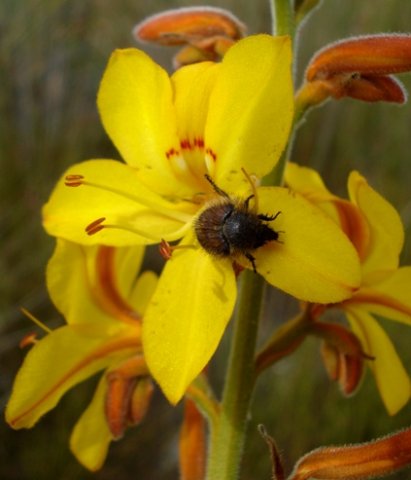Wachendorfia paniculata inspector

Author: Ivan Lätti
Photographer: Judd Kirkel Welwitch
Whether it is the Eagle that has landed, the first colonising party arriving on Mars or a hairy beetle touching down on a colourful corolla, there is always momentary exhilaration in the life event of arrival. Excitement comes from the partial achievement, but more from the proximity to what happens next.
The short journeys undertaken by insects are caused by the endless variations in flower charm that beckon and welcome. Attributes serving flowers to be noticed, recognised and favoured include scent, colour, shape, size, timing and, of course, the almost ubiquitous promise of nectar.
Pollen is the burden imposed by a flower upon its transient visitor seeking nectar. This happens instantly by delivery duties being assumed without awareness by whatever pollinator alights on the flower. This results in another delivery in the world’s oldest, largest and most bizarre postal system. No address label needs to be read, only pick another flower of the same species, pursuing the need to taste more of the same flavoured nectar.
Pollen, replacing postage stamps, is often produced in sumptuous quantities beyond a plants reproductive needs; as if moderation in this feature ever fits the design. Be it as it may, excess product does serve as food for the collaborating postmen and women. Bees are notable among pollen eaters.
To many it’s all about the sugar, not the pollen! Nectar, a sugary fluid secreted within flowers, give life to many billions of insects and other animals as staple food. This flies in the face of the Banting diet by favouring carbohydrates. What worked for Mr Banting, the undertaker, is against the best interests of flowering plants and causes no insect obesity (Wikipedia).

